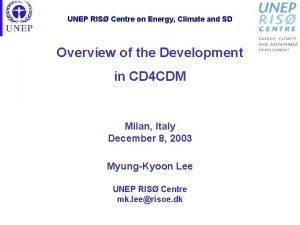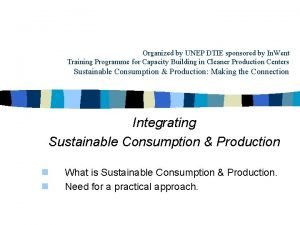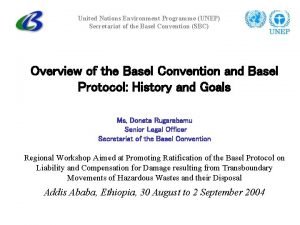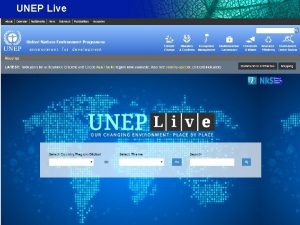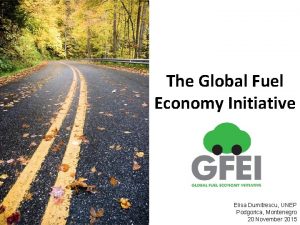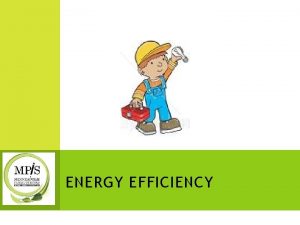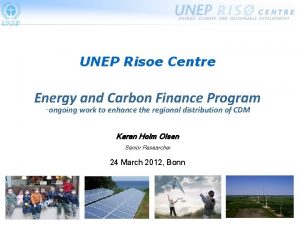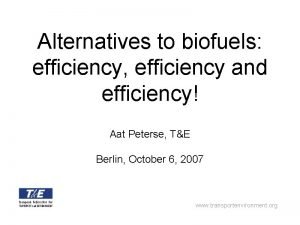UNEP FI ENERGY EFFICIENCY FINANCE Sarah Challe Energy











- Slides: 11

UNEP FI & ENERGY EFFICIENCY FINANCE Sarah Challe – Energy Efficiency Finance Specialist, UNEP Finance Initiative Overview 1. Why energy efficiency finance? 2. Policy engagement 3. Mobilization of the financial sector 4. Sharing best practices: Banks’ energy efficiency financing November 15 th-16 th, Lima 1

1/ WHY ENERGY EFFICIENCY FINANCE? Energy efficiency is the #1 climate action IEA Energy and Climate Change WEO Special Report 2015 According to Sustainable Energy for All, the energy efficiency investment gap amounts to $430 billion annually 2

UNEP FI’S LEADING ROLE IN EE FINANCE UNEP FI in a nutshell CHANGING FINANCE – FINANCING CHANGE A unique partnership between UN Environment and the private financial sector covering banks, investors, insurance • Connecting finance with energy efficiency policy • Facilitate exchange of experience and best practices among financial institutions 3

2/ POLICY ENGAGEMENT (EUROPE) Co-convening policy dialogues at the European level Ø 18 months work of the Energy Efficiency Finance Institutions Group reference Report informing European energy policy Ø Strengthen investor confidence through increased EE investment information DEEP database of >6000 projects Ø Bring policy/finance dialogue to national level in 15 countries next 3 years 4

2/ POLICY ENGAGEMENT (G 20) Member of G 20 Energy Efficiency Finance Task Group (EEFTG) Secretariat EEFTG gathers 14 countries to promote high-level investment enabling policy frameworks “Voluntary Energy Efficiency Investment Principles for G 20 Participating Countries” welcomed by G 20 Energy ministers and embedded in the G 20 Energy Efficiency Leading Program adopted in 2016 5

EXTENSIVE OUTREACH: G 20 EEFTG REACHED 1, 200 EXPERTS 95 EEFTG already engaged with around 1, 200 individuals through a programme of 18 workshops, contributions to G 20 and related activities in Europe, USA, China and Latin America 45 24 470 *Map in this section indicates events & number of participants 135 45 *including Webminar *Webinar 95 210 EEFTG Survey 72 6

3/ MOBILIZATION OF THE FINANCIAL SECTOR UNEP FI leads the engagement with private finance Leadership signal through a global mobilization of banks and investors on Energy Efficiency Statements 7

Facilitating learning through tools and dissemination Support & disseminate innovative initiatives ex: Energy efficiency mortgages • Capacity building & tools ex: Sustainable Real Estate Investment Guide, Energy Productivity Index Companies • 8

4/ SHARING EXPERIENCE & BEST PRACTICES Energy efficiency survey of banks: What did the survey say? üA well recognized opportunity: Large majority of respondents have energy efficiency financing activities and see it as an area of future growth Respondents by regions 2 2 Europe 5 ü Awareness raising and supportive policies are crucial to stimulate demand overcome barriers to market development Latin America 17 Asia Africa 10 North America ü Tracking of energy efficiency finance: Banks are deploying efforts to better track the volume of financing going to energy efficiency assets and projects 9

NEXT STEPS • Continued policy engagement Continued engagement with G 20 policy makers Ø Policy dialogues in Europe Ø Expand mobilization of financial institutions Ø • Enhancing knowledge & sharing best practices Ø Work on energy efficiency investment gap data Ø Develop and disseminate best practice case studies 10

THANK YOU! 11

